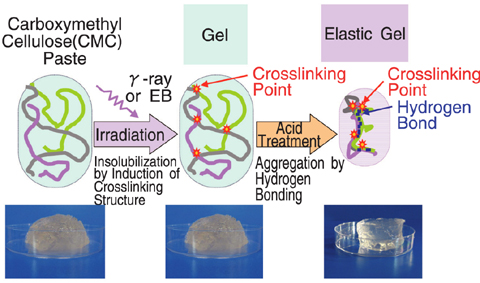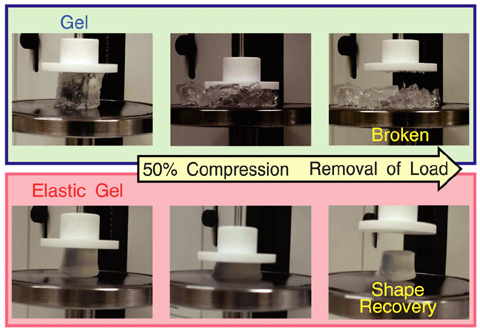
Fig.4-10 Preparation of biodegradable elastic gel

Fig.4-11 Mechanical property of biodegradable elastic gel
Development of cellulose, the chief material of plants which is produced through growth by photosynthesis, has received considerable attention as a carbon neutral high polymer. Though polysaccharide gel, manufactured from cellulose with crosslinking agents, absorbs hundreds of times its volume of water, its production is discouraged because the crosslinking agents are toxic in general.
To solve this problem, the development of a method to prepare the gel from water-soluble carboxymethylcellulose (CMC) without using a crosslinking agent was attempted. As a result, kneading CMC powder in water at a concentration of more the 10wt% yielded a homogeneous paste, and when the CMC in this condition was irradiated by γ-rays or electron beams, the crosslinking occurred and biodegradable gel was formed. Though the gel prepared by this technique had high water absorbency, the area of its application was very limited as the gel was fragile and brittle when swollen.
To solve this problem, the control of molecular structure is important, and we utilized the molecular aggregation caused by acid treatment to improve gel strength. We were able to make the rubbery elastic gel by immersing radiation-crosslinked CMC in an acid solution (Fig.4-10). The reason for this transformation is that a Na ion, which exists as a counter ion of a carboxyl group in the radiation crosslinked CMC gel, is replaced by hydrogen during immersion in the acid solution. As a result, the electrostatic repulsion power within the CMC molecular chain decreases, and the carboxymethylcellulose molecular chain agglomerates, pulled together by the hydrogen bond. Strong interaction between the molecules ensues. Measuring the thermal decomposition characteristics of the elastic CMC gel, it was found that a broadening and shifting of the peak to a higher temperature due to the decomposition of the CMC occurred only after immersion in the acid solution. This indicates that there is strong intermolecular interaction between CMC molecules.
Though the CMC gel made by the irradiation breaks up at 50% compression as shown in Fig.4-11, the elastic CMC gel does not break and returns to the same shape before it was compressed once the load is removed. The breaking strength of the acid treated elastic CMC gel was 150 times that of the untreated gel (3N/mm2). When the pH is lowered and the processing time of immersion is lengthened, this elastic CMC gel has increased strength and becomes harder, regardless of the kind of the acid. For instance, when the immersion processing is done for four days by using 0.5M hydrochloric acid, it becomes a gel that is about 100 times harder than that of CMC gel formed by radiation-induced crosslinking alone.
Thus, we succeeded in making a novel biodegradable gel with elasticity like rubber by the combination of radiation-induced crosslinking and acid treatment. Therefore, this elastic gel promises to be a new carbon neutral material of plant origin with a wide range of applications for cosmetics, environmental protection, and medical treatment.
This work was supported in part by Japan Science and Technology Agency, and is a product of the Gunma Prefecture Collaboration of Regional Entities for the Advancement of Technological Excellence.